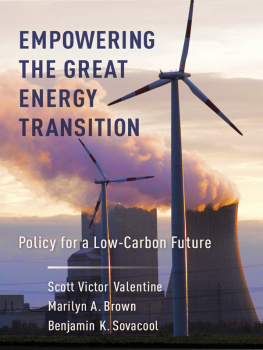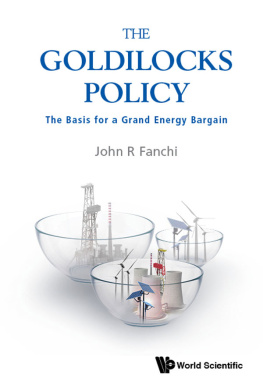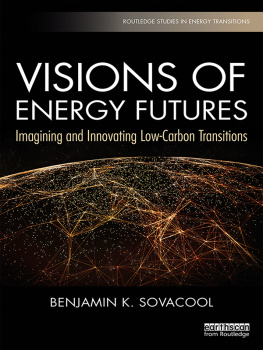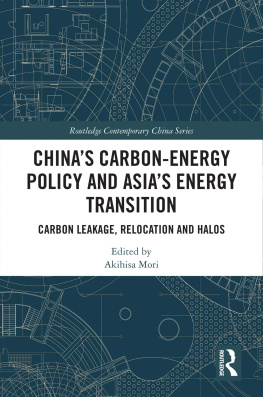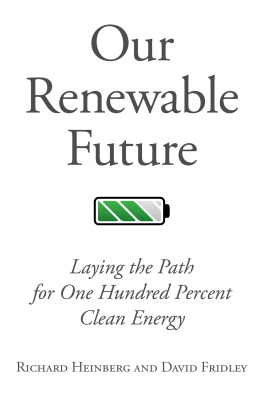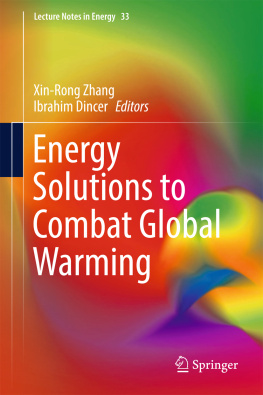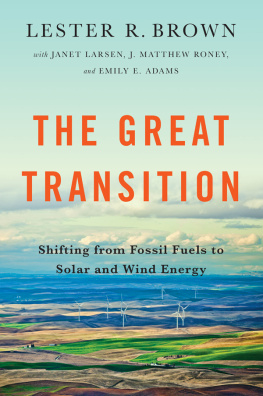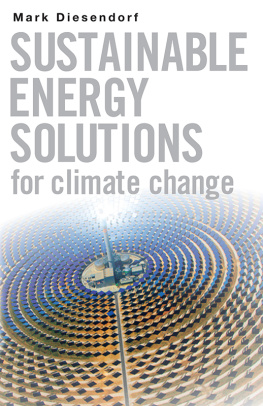Table of Contents
Empowering the Great Energy Transition
Empowering the Great Energy Transition
Policy for a Low-Carbon Future
Scott Victor Valentine, Marilyn A. Brown, and Benjamin K. Sovacool
Columbia University Press
New York
Columbia University Press
Publishers Since 1893
New York Chichester, West Sussex
cup.columbia.edu
Copyright 2019 Scott Valentine
All rights reserved
E-ISBN 978-0-231-54642-3
Library of Congress Cataloging-in-Publication Data
Names: Valentine, Scott V., author. | Brown, Marilyn A., author. | Sovacool, Benjamin K., author.
Title: Empowering the great energy transition: policy for a low-carbon future / Scott Victor Valentine, Marilyn A. Brown, and Benjamin K. Sovacool.
Description: New York: Columbia University Press, 2019. | Includes bibliographical references and index.
Identifiers: LCCN 2019007061 (print) | LCCN 2019980756 (e-book) | ISBN 9780231185967 (cloth; acid-free paper) | ISBN 9780231546423 (e-book)
Subjects: LCSH: Energy policyUnited States. | Clean energy industriesUnited States. | Renewable energy sources. | Climate change mitigationPolitical aspects.
Classification: LCC HD9502.U52 V35 2019 (print) | LCC HD9502.U52 (e-book) | DDC 333.790973dc23
LC record available at https://lccn.loc.gov/2019007061 LC e-book record available at https://lccn.loc.gov/2019980756
A Columbia University Press E-book.
CUP would be pleased to hear about your reading experience with this e-book at .
Cover image: plus49/Construction Photography/Avalon/Getty Images
Cover design: Lisa Hamm
Scott Valentine dedicates this work to Rebecca and Elle, my stars who help guide me. In loving memory of Ellery and Victor.
Marilyn Brown wants Frank and Katie Southworth to know how much their intellectual and moral support has meant.
Benjamin Sovacool wishes to thank his family as well for their continued support, but also four important mentors who have helped him grow personally and intellectually at critical moments in time: Brent Brossmann at John Carroll University, George Ziegelmueller at Wayne State University, Richard Hirsh at Virginia Tech, and, indeed, Marilyn Brown.
Contents
C ities, companies, and citizens across the globe are strengthening their commitment to sustainable practices and are considering alternatives to carbon-intensive and resource-abusive development pathways. Hotter summers, rising sea levels, forest fires, and climate extremes are beginning to persuade even recalcitrant onlookers that something is amiss. Success requires a transition in how we produce and consume energy, because the global reliance on fossil fuels has been one of the biggestif not THE biggestcause of pollution and environmental degradation in the world.
Fortuitously, low-carbon renewable energy systems have advanced remarkably and are more affordable than ever, and radical solutions for improving energy efficiency are now cost-competitive. But there are forces that resist change; their influence has made most governments unwilling to put a premium on the price of fossil fuels to reflect the human health and environmental damages they are causing. As a result, new policies and new business models are needed to mobilize and accelerate the clean energy transition.
Empowering the Great Energy Transition argues that a transition away from carbon-intensive energy sources is inevitable. It offers ways to expedite the transition, buoyed by a decade of technology breakthroughs.
At the same time, the book places issues of energy and climate justice front and center. A focus on equity is particularly important when public resources are being deployed or when vulnerable groups are affected. Empowering the Great Energy Transition takes up these themes and more.
Readers will be taken on a journey through the energy world as it is today; they will explore the numerous barriers to change and learn about the many developments that give us reason for optimism. With just a few adjustments, we can set humanity on a course to a new energy future that empowers entrepreneurs and communities, inspires innovation, and mitigates the damages caused by conventional energy technologies that have served their purpose. We describe the achievable steps that citizens, organizational leaders, and policymakers can take to put their commitments to sustainability into practice. Empowering the Great Energy Transition shows that, with just a few adjustments, we can set humanity on a course that motivates and supports entrepreneurs and communities that seek a cleaner energy future.
In sum, this book:
Is written by authors who together have produced over thirty books on energy and who are recognized experts in the field.
Begins with a strong and surprising assertion, supported by ten key market trends, that indicates that a transition away from carbon-intensive energy technologies is unavoidable.
Clarifies where the uncertainties of climate science lie and why these uncertainties impede market evolution.
Provides a politically infused assessment of the obstacles that are slowing a low-carbon energy transition.
Concludes with specific prescriptions to consumers, organizational leaders, and policymakers on how they can make a difference.
A ll three authors want to thank the editors and reviewers at Columbia University Press for their excellent suggestions for improvement. Support for this book was provided by the Brook Byers Institute of Sustainable Systems, the School of Public Policy and several engineering and science programs at the Georgia Institute of Technology that funded a workshop held in Atlanta in July 2017 to discuss interdisciplinary aspects of the global energy transition. That workshop enabled us to advance our concepts of technical and societal transformations with an audience that was deeply engaged in developing technology solutions to clean energy and climate change challenges.
A nyone who has experienced the joys of child-raising has had an I knew that was going to happen momenta phrase often uttered as a cup half-filled with some sort of stain-producing agent is launched off a table by a pudgy-armed baby. The agent bounces miraculously off the toe of your slipper before skittering across the floor to the foot of your new cloth designer bag. Then the lid of the cup that was holding the liquid comes unhinged, unleashing a torrent onto the kitchen floor and launching your new bag afloat on a sea of stain. But of course, you actually didnt know that was going to happen. You only suspected that something like that might happen. The likelihood of the cup departing on a journey of this type was, in your mind, perilously high. But the specific damage incurred was not preordained; it was merely a manifestation of Murphys Law. In short, this was a case of uncertain certainty, wherein general outcomes can be vaguely predicted, but not with specificity.
Uncertain certainty describes the energy sector today. There are clear indications that the energy sectordefined as the sociotechnical systems that supply and distribute energy services such as heat, mobility, hydraulics, and steamis transitioning away from carbon-based energy resources. Yet these trends do not impart specific insight into what the sector will transition to or how this transition will unfold. Predicting an endgame is of value for those seeking to predict future energy costs, technology-specific market trends, or geopolitical developments associated with energy transitions. But how can one do this? We know that the cup is about to come off the table, but where will it land?

